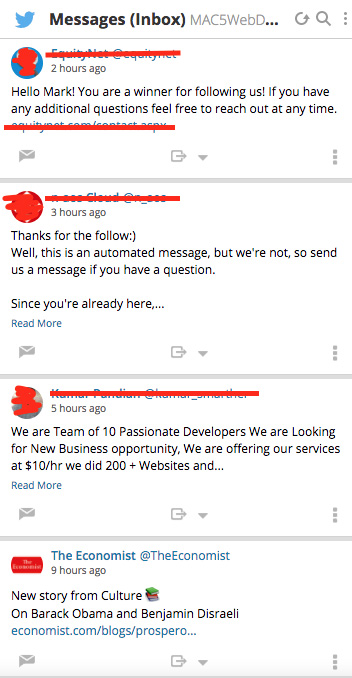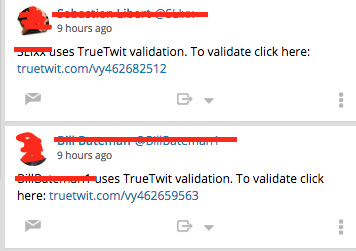Automated Direct Messages, If, How and When to Use Them
Let’s be honest for a quick second. Automated direct messages on social media kinda suck, don’t they? They’re typically impersonal, disingenuous and seemingly random. If the message was composed in such a way as to appeal to the most people, it probably won’t appeal to very many people – you know what I’m saying?
Pleas to “also connect” on LinkedIn or Facebook are the digital version of coming on too strong, especially if the automated DM arrives seconds after I decide to check you out on Twitter, I mean, I’m still deciding if I like you on the initial platform – I’m not at all ready to follow you anywhere else yet!
A Place for Automated Messaging
Having said that, there is a place for automated messaging in your marketing plan, we just need to tread carefully and be mindful of our messaging. If we’re going to be sending messages to people then those messages had better contain something of value – and not just a sweet discount on whatever you’re selling but something useful now, before the potential buyer is in full sales funnel mode.
Here’s an example. The screen shot shown below illustrates several automated direct messages we’ve received recently via Twitter. The first one is pretty basic and inoffensive and provides contact info in case we have any questions. No problem there, except that from the message I can’t quite figure out who they are and what they do so it’s a wasted effort because I’m unlikely to investigate further. After all, I get so many spammy DMs that I rarely click profiles to learn more about an unsolicited pitch.
The second message acknowledges the spammy nature of automation and invites us to click a link to try their product – only problem is that the link is hidden under the Read More button and as I pointed out earlier… I’m probably not going to go to the effort.
Message number 3 contains salesy sounding verbiage and is such a turn off that my eyes slid right past it to the message number 4 from the Economist. Finally, this is the sort of DM that might drive clicks. This is offering me something of value – a news story – without a sales pitch, without imploring me to follow the account somewhere else and without insincere broad language.
Automated Direct Messages – Marketing Fails ?
75% of these automated direct messages failed to entice me, if it weren’t for this blog post, I would never have given them a glance, let alone taken the time to read the text. Here is another classic example of wasted DMs… The much loathed, True Twit Validation.
The TrueTwit Spin
The premise behind TrueTwit is the prevention of time wasted on followers who are bots rather than humans. TrueTwit claims to validate your new followers to see if they are human by asking them to click a link to verify themselves. If you are spending marketing dollars on Twitter, I can see why you might want to ensure your efforts are being seen by real prospects.
Like What you See? Never miss a beat and Follow Our Blog!
The Reality
In truth though, I am here to tell you that I have never once – not ONCE – clicked on a TrueTwit link to prove to someone that I am real. I am still waiting to see if your tweets are worth my continued following so I’m not yet ready or interested in proving myself to them. This is spammy in itself and a waste of effort – the best way to ensure that your followers are real and are engaging with you is to engage with them. Did we really just have to write that? Yup! If you’re still spending money on this service, it’s time to give your head a shake and heres’s why:
They claim:
TrueTwit is designed to help you: Verify people from robots; Avoid Twitter spam
Then they disclose:
TrueTwit doesn’t make any kind of judgment as to whether or not anyone is or is not or may be or may not be a spammer.
Then finally admit:
If your follower successfully completes the CAPTCHA (or is already a TrueTwit user), you are sent an email indicating they are a TrueTwit-validated human!
So any bot or spammer can go and sign up for their service and they’re scott-free! TrueTwit makes a terrible first impression and first impressions last. Quit demanding verification and start providing excellent content and interesting conversations. Reach out directly when you see a follower with an interesting bio or tweet.
Don’t use a bot to demand that others prove they are not a bot.
Direct Message Best Practices
If you’re going to send automated direct messages you should never demand an action of your message recipient. Gentle nudges and suggestions make wonderful calls to action as long as there is a value or service provided – remember that Economist DM? The service provided was a link to an article I might like. Other options include offering Gift Cards for email sign ups, links to free downloads – as long as they are valuable and not just a landing page requiring more of the viewer’s data. Start looking at DMs as a way to have actual chats with other users, not just as a way to blast advertisements to prospects.
If you do plan to use a service to offer a gift card, thank new followers or otherwise say “HI” we have a couple of recommendations.
HOLR.COM (https://holr.co/)
This service is available for both Twitter and Instagram – the newest frontier for automated DMs. The free version offers up to 90 messages a day but those messages will include the HOLR branding. The paid versions at $19 and $29/month offer up to 120 messages without HOLR branding. The premium version even allows you to reach specific followers or even Instagram and Twitter users that don’t follow you in order to fine tune your communications or extend your reach.
Crowdfire.com (https://www.crowdfireapp.com)
To automate a DM click on “Automate” and enter your message. Click on Add More. Any new followers will now get your pre-written welcome message. CrowdFire keeps track of how many new followers you have every day as well as how many unfollows, which is never fun to see, but is critical to understanding how your marketing messages are being received.
One last thing before we wrap this up, Twitter has a page devoted to automation rules and best practises (https://support.twitter.com/articles/76915). This page is intended mostly for developers but you’ll get an idea of what’s ok and what’s not when you check it out.
*[Image credit: WALL-E (2008) Pixar / Disney]


